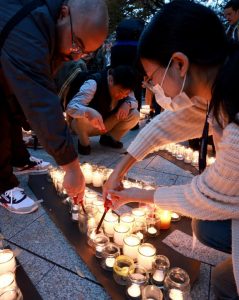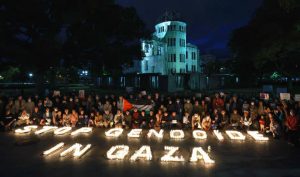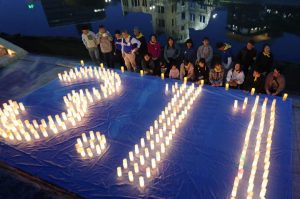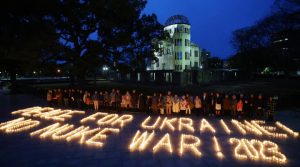Junior Writers Reporting: What are the thoughts of people by candlelight?
Dec. 12, 2023
Many of you have probably seen photographs or images of messages spelled out in candles in the dark of night. People hold a candlelight vigil to protest war, discrimination, persecution, oppression, and nuclear weapons that still exist in the world. They are also held to mourn victims. In Hiroshima, such events are often held before the Atomic Bomb Dome in the city’s Naka Ward. The Chugoku Shimbun’s junior writers report on the thoughts of the citizens by candlelight.
“Stop Genocide in Gaza”
On November 11, as Israeli forces continued their attack on Gaza in the autonomous Palestinian territories, about 500 people of different ages and nationalities gathered in front of the Atomic Bomb Dome. They lined up about 1,000 candles in glass jars one by one, and lit them to spell out the message: “Stop genocide in Gaza.”
The event was organized by the citizens group “Stop genocide Hiroshima.” Aoe Tanami, Associate Professor at Hiroshima City University and a member of the group, said, "You can see at a first glance what we are appealing to" when it is spelled out in candles, and "those who cannot put their thoughts into words can express them through action."
Many people were taking pictures of the candlelight with the Atomic Bomb Dome in the background. Ms. Tanami emphasized, “A message sent out from the A-bombed city has a great impact on people overseas.” After the event, we checked social networking sites (SNS) and found the participants had posted or shared the pictures. The message even reached the people of Gaza, who responded by saying: "It is encouraging," "It is our hope."
Yu Sato, 22, a senior at Hiroshima City University from Asaminami Ward who participated in the event, said, "I had not acted before because I did not know what I could do for the people of Gaza. (Today) I was able to create one message with many others who share the same feeling."
According to Ms. Tanami, more than two million people live in Gaza, and about half of them are 18 years old or younger. Gaza has been blockaded and bombed by Israel for 16 years. She wants the young Japanese generation to "know about the children who are crammed into a small land area, forced to live there, and their lives are taken away."
Power of candlelight with the Atomic Bomb Dome
At times, the people of Hiroshima send out their messages by holding a candlelight vigil in front of, or near, the Atomic Bomb Dome. For example, they protested Russia's invasion of Ukraine and the military crackdown on citizens in Myanmar, and commemorated the entry into force of the Treaty on the Prohibition of Nuclear Weapons (TPNW).
Tomoko Watanabe, 70, executive director of the incorporated non-profit organization “ANT-Hiroshima” (Hiroshima’s Naka Ward), said: “Candlelight has the power to reach out to the world across languages and generations.”
Ms. Watanabe, along with others, started such an event in 2003, calling on the United States to stop attacking Iraq by surrounding candles in silence. They chose a place near the Atomic Bomb Dome so people who saw the pictures or images would know at a glance that "the message came from the A-bombed city."
They share information with the world through social media when they hold a candlelight vigil to commemorate the atomic bombing of Nagasaki and a memorial service for the victims of the Great East Japan Earthquake. The event organized in January by the Hiroshima Alliance for Nuclear Weapons Abolition (HANWA)—of which Ms. Watanabe is also a member—on the second anniversary of the TPNW going into effect, to their surprise, attracted attention and was disseminated by citizens and pacifist groups around the world. Ms. Watanabe said firmly, “I will continue to put my anger and love into the candlelight, and continue to carry the voice of non-violence.”
Appealing with one heart
Candlelight vigils are often held overseas as a way to make an issue visible and well known, to unite as one, or to give each person a chance to reflect. The reasons for meetings vary: opposition to discrimination and violence, political protest, and commemoration of victims. We looked on the Internet to see what kind of candlelight vigils there were:
1. “Fight for 1 Point 5” ―Young people urged to tackle global climate change (to keep the temperature rise below 1.5 degrees Celsius compared to pre-industrial levels). (Germany 2020)
2. Residents held a candlelight vigil to mark the 40th anniversary of the Three Mile Island nuclear power plant accident, holding a banner that said No to Nuclear Power Plants. (The United States 2019)
3. A crowd walked with a penlight in hand at a rally demanding the resignation of then President Park Guen-hye. (South Korea 2016)
There were also other events, such as those that participants could join from home or other locations via YouTube. We seem to be able to share our thoughts no matter where we are.
The above article was written by the following junior writers:
Mei Kobayashi, 17; Shino Taguchi, 17; Riko Soma, 15; Sakura Tanimura, 15; Mao Tonoshige, 15; Manami Nakano, 16; Karin Fujiwara, 16; Misuzu Mori 16; Natsuki Yamashiro, 15; Gaku Kawanabe, 14; Rin Matsufuji, 13; Terukazu Yazawa, 14; Haruki Yukitomo, 14; Emi Ishii, 13; and Ayako Yamashita, 13.
(Originally published on December 12, 2023)
Junior writers participated in the candlelight vigil
“Stop Genocide in Gaza”
On November 11, as Israeli forces continued their attack on Gaza in the autonomous Palestinian territories, about 500 people of different ages and nationalities gathered in front of the Atomic Bomb Dome. They lined up about 1,000 candles in glass jars one by one, and lit them to spell out the message: “Stop genocide in Gaza.”
The event was organized by the citizens group “Stop genocide Hiroshima.” Aoe Tanami, Associate Professor at Hiroshima City University and a member of the group, said, "You can see at a first glance what we are appealing to" when it is spelled out in candles, and "those who cannot put their thoughts into words can express them through action."
Many people were taking pictures of the candlelight with the Atomic Bomb Dome in the background. Ms. Tanami emphasized, “A message sent out from the A-bombed city has a great impact on people overseas.” After the event, we checked social networking sites (SNS) and found the participants had posted or shared the pictures. The message even reached the people of Gaza, who responded by saying: "It is encouraging," "It is our hope."
Yu Sato, 22, a senior at Hiroshima City University from Asaminami Ward who participated in the event, said, "I had not acted before because I did not know what I could do for the people of Gaza. (Today) I was able to create one message with many others who share the same feeling."
According to Ms. Tanami, more than two million people live in Gaza, and about half of them are 18 years old or younger. Gaza has been blockaded and bombed by Israel for 16 years. She wants the young Japanese generation to "know about the children who are crammed into a small land area, forced to live there, and their lives are taken away."
From the A-bombed city
Power of candlelight with the Atomic Bomb Dome
At times, the people of Hiroshima send out their messages by holding a candlelight vigil in front of, or near, the Atomic Bomb Dome. For example, they protested Russia's invasion of Ukraine and the military crackdown on citizens in Myanmar, and commemorated the entry into force of the Treaty on the Prohibition of Nuclear Weapons (TPNW).
Tomoko Watanabe, 70, executive director of the incorporated non-profit organization “ANT-Hiroshima” (Hiroshima’s Naka Ward), said: “Candlelight has the power to reach out to the world across languages and generations.”
Ms. Watanabe, along with others, started such an event in 2003, calling on the United States to stop attacking Iraq by surrounding candles in silence. They chose a place near the Atomic Bomb Dome so people who saw the pictures or images would know at a glance that "the message came from the A-bombed city."
They share information with the world through social media when they hold a candlelight vigil to commemorate the atomic bombing of Nagasaki and a memorial service for the victims of the Great East Japan Earthquake. The event organized in January by the Hiroshima Alliance for Nuclear Weapons Abolition (HANWA)—of which Ms. Watanabe is also a member—on the second anniversary of the TPNW going into effect, to their surprise, attracted attention and was disseminated by citizens and pacifist groups around the world. Ms. Watanabe said firmly, “I will continue to put my anger and love into the candlelight, and continue to carry the voice of non-violence.”
Overseas
Appealing with one heart
Candlelight vigils are often held overseas as a way to make an issue visible and well known, to unite as one, or to give each person a chance to reflect. The reasons for meetings vary: opposition to discrimination and violence, political protest, and commemoration of victims. We looked on the Internet to see what kind of candlelight vigils there were:
1. “Fight for 1 Point 5” ―Young people urged to tackle global climate change (to keep the temperature rise below 1.5 degrees Celsius compared to pre-industrial levels). (Germany 2020)
2. Residents held a candlelight vigil to mark the 40th anniversary of the Three Mile Island nuclear power plant accident, holding a banner that said No to Nuclear Power Plants. (The United States 2019)
3. A crowd walked with a penlight in hand at a rally demanding the resignation of then President Park Guen-hye. (South Korea 2016)
There were also other events, such as those that participants could join from home or other locations via YouTube. We seem to be able to share our thoughts no matter where we are.
The above article was written by the following junior writers:
Mei Kobayashi, 17; Shino Taguchi, 17; Riko Soma, 15; Sakura Tanimura, 15; Mao Tonoshige, 15; Manami Nakano, 16; Karin Fujiwara, 16; Misuzu Mori 16; Natsuki Yamashiro, 15; Gaku Kawanabe, 14; Rin Matsufuji, 13; Terukazu Yazawa, 14; Haruki Yukitomo, 14; Emi Ishii, 13; and Ayako Yamashita, 13.
(Originally published on December 12, 2023)











